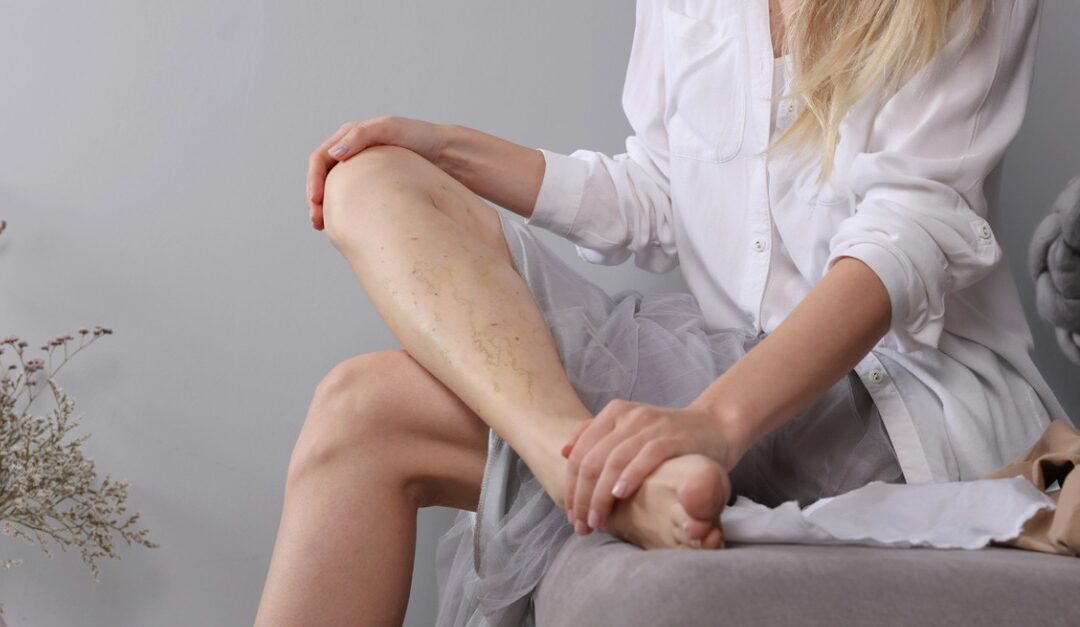Author: Arun Chervu, MD, FACS, RVT, MBA, MHA, Board-Certified Vascular Surgeon
Types of Venous Diseases
Spider Veins are the small, visible veins which often have the appearance of having been drawn on the skin, with a fine pen. They do not bulge out beyond the skin, but can be unsightly, and can also be associated with itching or discomfort, though they are considered cosmetic.
Varicose Veins are the bulging veins, often seen on the thighs and legs. As they grow larger, they can cause more pain, itching, burning, fatigue, and become more unsightly. Varicose veins are not just a cosmetic issue but can often be a sign of an underlying vein condition known as Chronic Venous Insufficiency (CVI).
CVI is one of the most common vascular conditions worldwide and is twice as prevalent as heart disease and five times more prevalent than peripheral arterial disease. CVI is due to blood flowing backwards (refluxing) in the superficial veins due to malfunctioning valves. This leads to blood pooling in the legs, especially in the calves and feet, leading to a variety of symptoms including leg heaviness/fatigue, restless legs, Charley horse/night cramps, itching, spider and varicose veins, skin discoloration, numbness/tingling (i.e. neuropathy), and venous ulcers. CVI affects 25% to 90% of the population in their lifetime and is one of the greatest epidemics in this country that goes undiagnosed. The diagnosis of CVI is done with a venous reflux ultrasound done in the office with minimal discomfort by our vascular technician followed by a provider visit.
Treatment Options
Compression stockings, usually knee-high along with exercise and weight loss are the initial treatments of CVI. Compression stockings improve blood flow in two ways. First, they improve the function of the muscle pump system in your calf. Second, they minimize pooling of blood in the dependent portion of your legs secondary to gravity. Compression stockings come in different strengths measured in “millimeters of mercury”, just like your blood pressure. The lowest strength ranges from 8-15 mmHg and are often used in hospitals to reduce the risk of blood clots (aka deep vein thrombosis, DVT). The highest strength is 40-50 mmHg and is used for those with lymphedema or severe venous disease. The most common strength is 20-30 mmHg and is used for patients with chronic venous insufficiency (CVI). While it is true that compression stockings cannot prevent CVI, they can minimize the severity of CVI and delay the onset of symptoms. People with history of blood clots, obesity, inactivity and in jobs that require prolonged sitting or standing should wear compression stockings.
Fortunately, there have been several advancements in our treatment of vein problems. Most of them can be done in the office, with minimal discomfort, and very little recovery time. Most of the time, patients can return to work and regular activities the day after treatment, or even the same day.
For patients with varicose veins, treatment is first focused on venous insufficiency, if it is present. Depending upon which vein or veins are affected, they may be able to be sealed off, to prevent the blood flowing backwards in the superficial veins. For several years, we have used endovenous laser treatment (EVLT) or radiofrequency (VenefitTM) to close off the refluxing veins. These modalities have been been shown to be very safe and over 95% effective.
Most recently, a special surgical adhesive, called Venaseal ™, has allowed us to glue the incompetent veins shut. This exciting new procedure has virtually no discomfort and has shown equally good results but is currently limited to only certain insurance carriers. Often, closing off the malfunctioning veins, will allow the varicose veins to collapse down, and flatten out. In some cases, the more superficial veins below the area of vein closure do not completely disappear and these veins can be removed through tiny incisions in the office, a procedure called stab phlebectomy.
Another minimally-invasive, non-surgical option is to use Varithena™ to administer a small amount of micro foam into affected veins. The vein then collapses, and blood is redirected to healthier vessels nearby. Veins both above and below the knee can be treated using this method, and it’s appropriate for veins with a range of diameters, from small to large. Twisted veins and veins that have been treated unsuccessfully with other methods may also respond to Varithena. Your vascular surgeon can discuss treatment options with you during your initial consultation.
Spider veins are mainly treated for their appearance. We can use medications including hypertonic saline and AscleraTM to make these tiny veins shrivel up and disappear. Sometimes, we can shine special laser light on the veins, to make them go away.
The results of treatment for vein problems have been excellent. Today’s minimally invasive procedures are often dramatic, and long-lasting. The patient’s frequently report feeling better, with more energy, and less tiredness in their legs.
What To Do Next
In conclusion, there is no need to continue suffering from tired legs or unsightly veins, with the availability of modern vein treatment. Better feeling and more attractive legs, are more accessible to men and women, than ever before. If you suffer from these types of problems, or know someone who does, a quick evaluation by a qualified Vascular Surgeon, is just an office visit away.

About the Author – Arun Chervu, MD, FACS, RVT, MBA, MHA, is a board-certified Vascular Surgeon. He has been practicing in Northwest Georgia, for almost 27 years and for the last year has extended his practice to the Roswell/Alpharetta area. He is a partner at Vascular Surgical Associates, PC and Vein Specialists of Northwest Georgia. Vascular Surgical Associates and Vein Specialists of Northwest Georgia currently have eleven convenient locations to serve your needs. The Alpharetta office is located at 5755 North Point Parkway, Suite 214. You may reach the office at 770-423-0595.





